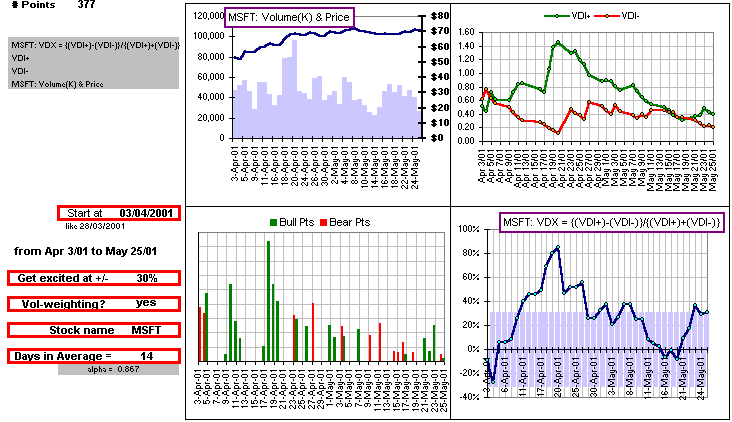|
Volume-weighted Exponential Moving Average (V-EMA) and the Directional Movement Indicator |
We collect Price and Volume data for some stock (or mutual fund), for the past N days, namely:
(P1, V1), (P2, V2),
(P3, V3), ...
(PN, VN)
and compute, with this info:
Num(Now) = EMA of last N values of (Volume)*(Price)
and
Den(Now) = EMA of last N values of (Volume)
>That doesn't explain how to calculate them!
Patience. Tomorrow, once we've got the Price, PN+1, and Volume, VN+1,
we calculate:
and "Num" and "Den" stand for Numerator and Denominator, respectively
Magic Formula :
V-EMA(Next) = Num(Next)/Den(Next)
where
Num(Next) = α Num(Now) + (1 - α) VN+1 PN+1
and
Den(Next) = α Den(Now) + (1 - α) VN+1
and α = 1 - 2/(N + 1) so, for N = 14 (a 14-day V-EMA) we'd have α = 1 - 2/15 = 0.867
(See Technical Analysis stuff.)
To start this procedure (before we've got a bunch of Prices and Volumes) we just use
Num(Now) = (1 - α) Volume x Price and Den(Now) = (1 - α) Volume
Thereafter, we use the Magic Formula.
>Example?
Okay, suppose the closing Price and Volume are $23.50 and 5,250.9, in thousands of shares traded.
Suppose, further, that we're working with a 14-day moving average, so
α = 0.867.
and
Num(Now) = (1-0.867) (5,250.9) (23.50) = 16,412
and
Den(Now) = (1-0.867) (5,250.9) = 698.37
so
V-EMA(Now) = Num(Now)/Den(Now) = 16412/698.37 = $23.50 hence ...
>But that's just today's price!
I'm glad you noticed. However, we need to have a starting value for Num and Den.
Tomorrow, we suppose that our Price and Volume are $24.50 and 1,477.8 kilo-shares, so now
we use Magic Formula :
Num(Next) = α Num(Now) + (1 - α) VN+1 PN+1 = 0.867(16412)+(1-0.867)(1477.8)(24.50) = 19044.6
and
Den(Next) = α Den(Now) + (1 - α) VN+1 = 0.867(698.37)+(1-0.867)(1477.8) = 802.03
so
V-EMA = 19044.6/802.03 = $23.74
>And so on ... and so on.
Right. As we continue, we generate a Volume-weighted Exponential Moving Average and ..
>Is that what you're after? A Volume-weighted ...?
Well ... uh ... not exactly. We're really after a Volume-weighted
Directional Movement Indicator (DMI).
>I've forgotten what that is.
Then go back and read the Technical Analysis stuff. However,
in a nutshell, we calculate a sequence of Bull Points
and Bear Points (depending upon the increases in
the daily highs compared to the decreases in daily lows) and we then compute the Exponential
Moving Averages (EMA) of these two sequences of Bull
and Bear points, calling these EMAs
DMI+ and DMI- and we get excited
when DMI+ rises above DMI-
because we then expect the stock to take off ... so we look at their difference:
ADX = (DMI+) - (DMI-) so that ...
|
>But it could go the other way. I mean ... Without using the Volume weighting (but just the standard DMI), the ADX doesn't go negative in early May. However, if we include the Volume, the VDX goes negative ... for a week or so.
>So what's the moral of this story? >What's significant?
VDX = 100 { (VDI+)-(VDI-)} /{ (VDI+)+(VDI-)} then we'd get a "percentage" and we'd relax unless the VDX rose above, say, 30% or fell below, say, -30%:
 >So if I see the VDX drop to -15%, as in the above chart, I just go back to sleep. Exactly. |
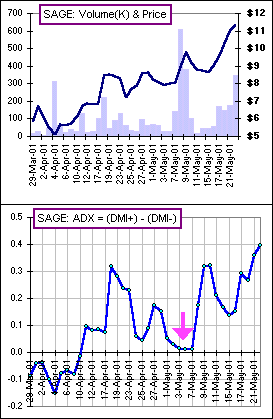 
|
Just RIGHT-click on the picture to download the .ZIP'd spreadsheet.
In the meantime, here's a few VDXs (as opposed to ADXs) to ponder:




|
And, for a change of pace (because there ain't no Volume figures for this Index),
the ADX for the Nasdaq, below:

>But what about the big drop in the NAZ, last year?
>So, it looks like ADX anticipated the drop ...sorta ... if we get excited about a 30% drop. >Well ... uh ... not really. |

|

|
>For example, would this ADX stuff have kept you out of the
Nasdaq, for all of the year 2000? Good question ... let's see. Suppose we have $1,000 invested in the Nasdaq, in January, 2000 and we watch the ADX. When it drops below -30% we sell everything, put the money under a pillow and wait. When the ADX goes above 30% we buy back in ... and stay in until it drops below -30% again. >Looks like you made 12.9% for the year while the NAZ dropped ... what? Over 40%. Yes, but notice that I sold in March and held the cash until the end of May. I also bought back in, sometime near the end of August, and got out later when the ADX dropped from +30% to -30% in about a week or so ... and I lost money! >So, do you believe in this technical analysis stuff? |

| So, guess what stock we should worry about, now, on May 27, 2001?
>How many guesses do I get? Just one. >Pfizer? Are you sure? Ask me again in a week or three. |
|
... here's a more recent Pfizer:
>Aha! So your prediction is lousy!
Ya win some. |

|
>But is VDX, the volume-weighted stuff, really better than ADX??
Uh ... let's try it on some stock that's been around for a while, like maybe ...
>How about General Electric. It's been around since the DOW had only a dozen stocks and I'd say that ...
Okay, here's what we'll do:
On the right, the final result (from Jan/85 to Jun/01)
| 
|
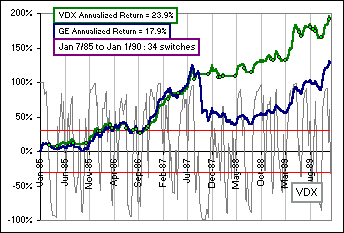
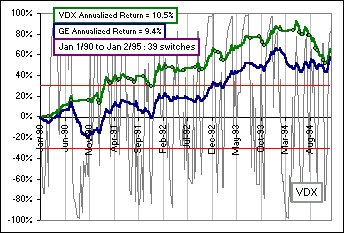
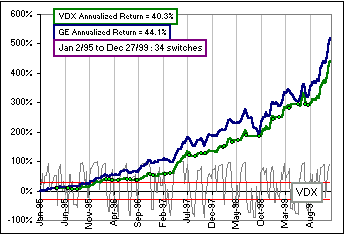
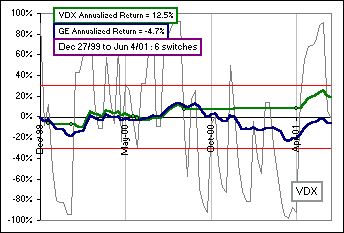
>So what was the annualized gain for the ...?
For GE, the annualized gain from Jan/85 to Jun/01 was 20.0% and for VDX it was 23.1%.
>What about ADX? What if you just ignored the volume?
For ADX the annualized gain was about 22.9%.
>Big deal!
Aah ... but if you had $100K invested for those years, it'd make a difference of over $100,000
in your final portfolio - if you used VDX instead of ADX - from about $2.9M to $3.0M and
that's significant, eh? And if we just did a buy-and-hold with the GE stock, we'd have about $2M
by June/01.
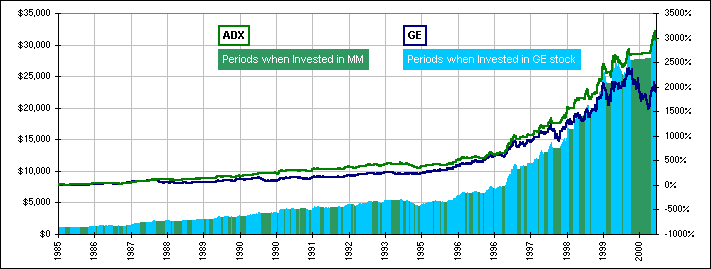
>That 4-week averaging. Is that the best number? And that 30% figure - what about ...?
The 30% is up to you. I call it the tranquility parameter.
You want tranquility? Choose +/- 100%, relax, do nothing.
You need the adrenaline rush?
Choose +/- 5%.


>Aha! So you looked at the historical data and picked the parameters, like 4-week and 30%, so as to make VDX look good!
Well ... uh, one must use historical data for each stock in order to gauge the appropriate
parameters for that particular stock. I mean, not all stocks behave in the same way.
Some are more volatile. Some are ...
>Mumbo Jumbo. Besides, you ignore the cost of trading and
what about longer time spans and ...?

>And if you ignored the volume and just used ADX?
The annualized gain would have been ... uh ... 17.0%, but I must say that it makes more sense to
include the volume. After all, share prices associated with a higher volume surely are
more important than the share price when just a few shares trade. There are usually more people
involved. Volume-weighted prices give us an estimate of the average price paid for a stock.
Using the price, alone, is like saying the size of a car - ignoring the weight
of the car - that just its size alone will determine how much force is required to move the
car. It's like saying that ...
>zzzZZZZ
For gyrfalcon and other Nortel- and XIU-watchers:
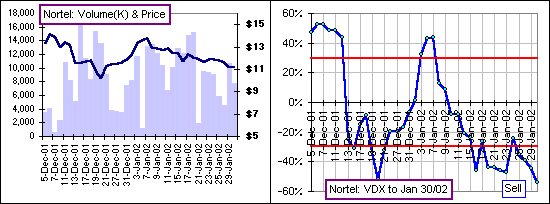
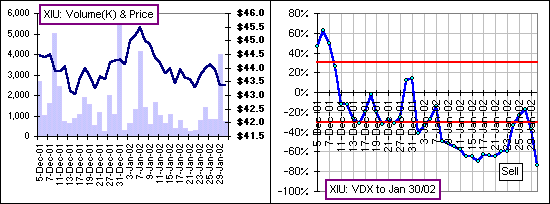
See Part II
NOTE: There's a simple spreadsheet available. You just type in the Stock Symbol, click a button (while you're connected to the Net!) and it downloads the pertinent data and plots the VDX (thanx to Ron M!). The spreadsheet looks like this.
To download the spreadsheet, RIGHT-click HERE and "Save Target" or "Save Link".



